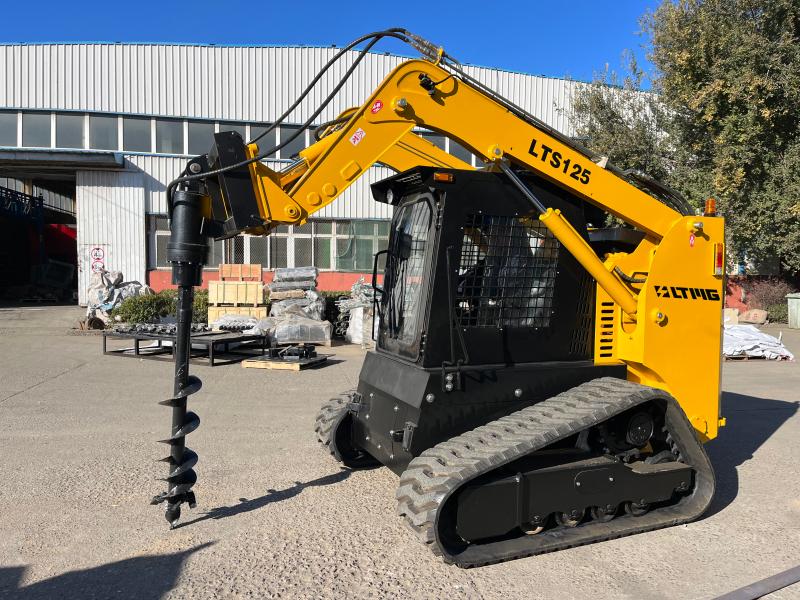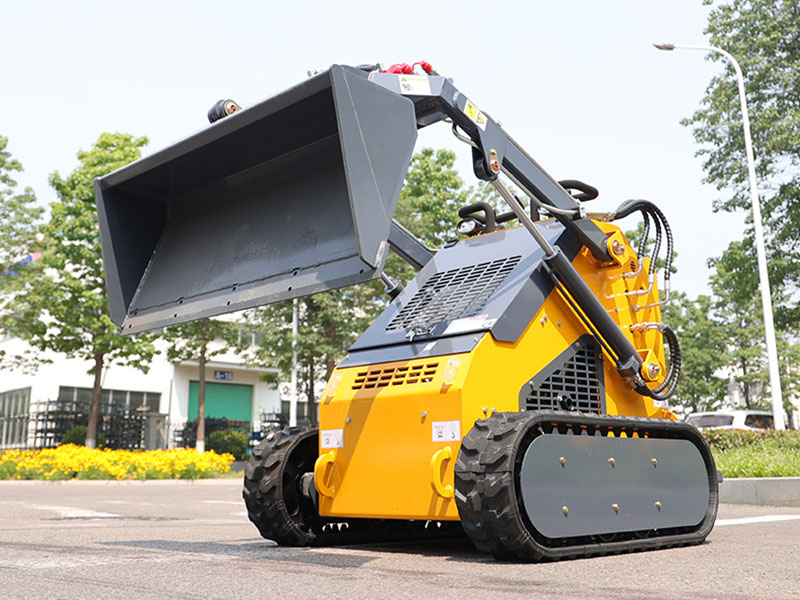What are the main uses for a skid steer?
Jun 11, 2024
The biggest feature of a skid steer loader is that the overall dimensions of the machine is small, and can realize the in-situ steering; can be randomly and quickly replaced at the scene of operation or hooked up to a variety of working devices, the use is very wide, covering a variety of industries and fields. Its use is mainly in the following areas:
1. Snow removal: in the snow removal industry, skid steer loaders can be directly used for snow clearing and cleaning operations, with snow clearing, and de-icing accessories, skid steer equipment can quickly clean up large areas of snow and ice.
2. Highway construction and maintenance: in the highway industry, skid steer loaders can be used for paving, repairing, and cleaning tasks.
3. Gardening and agriculture: In the gardening and agriculture sector, skid steer loaders can be used for planting, fertilizing, harvesting, and other activities.
4. Construction industry: In the construction industry, skid steer loaders can be used for tasks such as building construction, demolition, and material handling.
5. Indoor floor treatment: skid steer loaders can also be used for chiseling all kinds of newly poured indoor floors or damaged floors, applicable to reservoirs, dam leakage, dangerous bridge reinforcement, power plants, highways, and other projects.
6. Narrow space operation: Because its minimum turning radius is still less than half of the articulated loader of the same grade, it is especially suitable for use in an environment with a narrow operation site, uneven ground, and frequent change of operation content, such as urban infrastructure, roads or construction sites, workshops, warehouses, wharves, decks of ships and even cabins.
7. Multifunctionality: skid steer loaders can be replaced or hooked up with different working devices to adapt to a variety of working conditions and task requirements, with a high degree of versatility and flexibility.
What are the specific application cases of skid steer loaders in snow removal fields?
The specific application cases of skid steer loaders in the snow removal field include the following aspects:
1. Highway restoration: XCMG skid steer loaders play an important role in highway restoration, being able to choose dozens of implements for snow removal and other related work.
2. Municipal gardens: Skid steer loaders of Manitou Group are widely used in municipal gardens for snow clearing and throwing.
3. Agricultural field: Bobcat skid steer loaders are also used in the agricultural field for snow removal, helping farmers remove snow from the fields and ensure the normal growth of crops.
4. Ranch cleanup: skid steer loaders are also used in ranch cleanup to help remove snow on the ranch and ensure the safety and health of animals.
5. Industrial field: In the industrial field, skid steer loaders can be equipped with snow blowers and other equipment, which are used to remove snow from factory workshops and warehouses to keep the production environment dry and safe.
How can skid steer loaders improve productivity in gardening and agriculture?
The way skid steer loaders improve productivity in gardening and agriculture is mainly reflected in the following aspects:
1. Flexibility and compact models: skid steer loaders have a small body and a short turning radius, making them suitable for narrow space operations. For example, Eason skid steer loader HY400 has a body of only 729 mm and a small turning radius of less than 2 meters, which is ideal for complex terrain in gardening and agriculture.
2. Multi-functionality: skid steer loaders are usually equipped with multi-functional buckets, which can perform a variety of tasks such as bulldozing, loading, grading, and digging. For example, the Bobcat S160 skid steer loader can accomplish these tasks on farms.
3. High efficiency: skid steer loaders can complete greening operations in a timely and efficient manner and improve the grade of urban greening. Its versatility and ease of operation make it play an important role in enhancing work efficiency.
4. Specialized tooling: To further improve machine efficiency in nursery and landscaping applications, Caterpillar has introduced new tooling for its range of Cat® skid steer loaders.
5. Wide range of applications: Skid steer loaders are not only used in a wide range of construction projects but also play an important role in the fields of gardening, landscaping, agriculture, and water conservancy. In agriculture, they can be used to clean barns, transport feed or maintain farms.
6. Economy: The high load capacity and durability of skid steer loaders bring great convenience to the production activities of various industries and help companies save time and cost.
What are the technological trends of skid steer loaders in the construction industry?
In the construction industry, the technological development trend of skid steer loaders is mainly reflected in the following aspects:
1. Electrification: The 385B-E electric skid steer loader launched by LiuGong is the first electric skid steer loader in China, which marks a breakthrough in the direction of electrification of skid steer loaders. The equipment is independently developed and manufactured by LiuGong, and the key components are fully localized, successfully breaking through the “neck” technology such as hydraulic components manufacturing.
2. Innovative design: JCB released the world's first telescopic boom skid steer loader, which demonstrates the innovation in skid steer loader design. This telescopic boom technology not only improves operational flexibility but also significantly improves work efficiency and safety.
3. Market segmentation and specialization: With the diversification of market demand, skid steer loaders are also being segmented and specialized. For example, the XCMG XC770K skid steer loader is successfully applied in the field of floor construction, which shows that skid steer loaders are gradually entering more specialized fields.
4. Compact skid steer loaders: Compact skid steer loaders are becoming more and more popular in the market due to their portability and flexibility. Relevant reports provide an in-depth analysis of this market segment and forecast its market size, price trends, and growth trends.
5. Continuous Innovation and Durability: Case, as a pioneer in skid steer loaders, has always been committed to designing products that are advanced, strong and durable, and have a long service life. This continuous technological innovation and pursuit of high-quality standards has enabled Case to maintain its leadership position in the skid steer loader segment.
Technological trends for skid steer loaders in the construction industry focus on motorization, innovative design, market segmentation and specialization, compact products, and continuous innovation and durability.
What are the operating tips and safety measures for skid steer loaders in confined space operations?
When skid steer loaders are operating in confined spaces, operating tips and safety measures are critical to ensure the safety of the operator and the proper functioning of the equipment. Below are some specific operating techniques and safety measures:
Operating Skills:
1. Skillful mastery of the operation method: Due to the simple structure and easy operation of the skid steer loader, the operator can quickly master its various operation techniques through simple training.
2. Get in and out of the machine correctly: when getting in and out of the machine, you should keep three points of contact (feet, hands, back), face the machine, do not take tools, and do not jump to operate the machine.
3. Use safety armrests: To prevent the operator from accidentally leaving the seat, you can use the safety armrests equipped with the skid steer loader.
4. Cab design: The cab is spacious with good visibility and all instruments are arranged in the front where they can be easily observed, which helps the operator to better control and monitor the equipment.
Safety Measures:
1. Mechanical safety measures: These include guards, flaps, and safety gates to ensure that the load will not fall off from the outside of the machine.
2. Power safety measures: such as safety locks and power protection to ensure that the load is safely pushed into the fuselage.
3. Four safety measures: Skid steer loaders are usually equipped with four safety measures to ensure that the operator operates safely.
4. Emergency management: For the characteristics of limited space operation, an emergency plan is formulated and relevant emergency equipment and devices such as respirators, gas masks, communication equipment, safety ropes, etc. are equipped.
5. Consideration of environmental factors: When operating in a confined space, special attention needs to be paid to environmental factors such as poor ventilation and lighting, which may lead to the accumulation of toxic and harmful gases, and often cause serious consequences in case of accidents.
6. Suspension of prohibited operation signs: When carrying out maintenance or repair, prohibited operation signs must be suspended to prevent accidental operation.
As a famous manufacturer in China, LTMG skid steer loaders range from 300kg to 1500kg, meeting various operational needs. With a variety of attachments such as buckets, breakers, and snow blowers, you can quickly switch tools to enhance work efficiency. Additionally, multiple engine options ensure our loaders adapt to different working conditions and environments. LTMG skid steer loaders, with their compact and flexible design, are widely used in agriculture, construction, and municipal services. Choosing LTMG means selecting an efficient, versatile, and reliable work partner.




